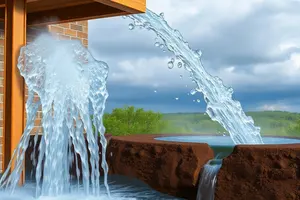Podcast
Questions and Answers
What is the primary process by which water is transformed from its liquid state to water vapor?
What is the primary process by which water is transformed from its liquid state to water vapor?
- Condensation
- Precipitation
- Transpiration
- Evaporation (correct)
Which of the following factors decreases evaporation?
Which of the following factors decreases evaporation?
- Humidity (correct)
- Temperature
- Wind
- Surface Area
What type of evaporation occurs through plants, releasing water vapor into the air through their leaves?
What type of evaporation occurs through plants, releasing water vapor into the air through their leaves?
- Plant Transpiration (correct)
- Soil Evaporation
- Atmospheric Evaporation
- Surface Evaporation
What is the role of evaporation in the water cycle?
What is the role of evaporation in the water cycle?
Why does an increase in surface area lead to an increase in evaporation?
Why does an increase in surface area lead to an increase in evaporation?
What is the importance of evaporation in maintaining healthy ecosystems?
What is the importance of evaporation in maintaining healthy ecosystems?
Flashcards are hidden until you start studying
Study Notes
Evaporation
Definition: Evaporation is the process by which water is transformed from its liquid state to water vapor.
Key Factors:
- Temperature: Evaporation increases with temperature. Higher temperatures provide more energy for molecules to escape the surface.
- Humidity: Evaporation decreases with high humidity. When the air is already saturated with water vapor, it's harder for more water to evaporate.
- Wind: Evaporation increases with wind. Wind helps to remove the water vapor from the surface, allowing more evaporation to occur.
- Surface Area: Evaporation increases with surface area. A larger surface area exposes more water molecules to the air, allowing for more evaporation.
Types of Evaporation:
- Surface Evaporation: Evaporation from the surface of oceans, lakes, and rivers.
- Plant Transpiration: Evaporation from plants, which release water vapor into the air through their leaves.
- Soil Evaporation: Evaporation from the soil, which occurs when the soil is moist and the air is dry.
Importance of Evaporation:
- Water Cycle: Evaporation is the first step in the water cycle, allowing water to move from the Earth's surface to the atmosphere.
- Weather Patterns: Evaporation helps to create weather patterns, such as clouds and precipitation, by adding water vapor to the air.
- Ecosystems: Evaporation plays a crucial role in maintaining healthy ecosystems, as it helps to regulate the water balance and support plant growth.
Evaporation
- Evaporation is the process of transforming water from its liquid state to water vapor.
Factors Affecting Evaporation
- Higher temperatures increase evaporation, providing more energy for molecules to escape the surface.
- Evaporation decreases with high humidity, as the air is already saturated with water vapor.
- Wind increases evaporation by removing water vapor from the surface, allowing more evaporation to occur.
- A larger surface area exposes more water molecules to the air, increasing evaporation.
Types of Evaporation
- Surface evaporation occurs from the surface of oceans, lakes, and rivers.
- Plant transpiration occurs when plants release water vapor into the air through their leaves.
- Soil evaporation occurs when the soil is moist and the air is dry.
Importance of Evaporation
- Evaporation is the first step in the water cycle, allowing water to move from the Earth's surface to the atmosphere.
- Evaporation helps create weather patterns, such as clouds and precipitation, by adding water vapor to the air.
- Evaporation maintains healthy ecosystems by regulating the water balance and supporting plant growth.
Studying That Suits You
Use AI to generate personalized quizzes and flashcards to suit your learning preferences.




